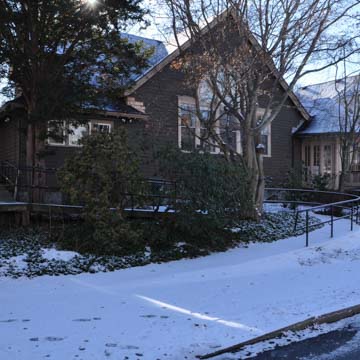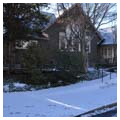Fraternal organizations blossomed in the United States in the nineteenth century. In addition to the well-known male fraternal organizations such as the Freemasons and Oddfellows, women’s organizations formed to converse about and advocate for suffrage, temperance, and education. In November 1889, one such group of mainly upper-class white women organized in Andover in part to foster a community that encouraged cultural exchange. It took the name “November Club” in honor of its month of creation. Two years later, one of its founding members, Bessie Goldsmith, encouraged her father to sell to the organization a vacant lot on which to build a clubhouse. The building, finished in 1892, was New England’s first structure specifically built to function as a clubhouse for women. Designed in the newly fashionable Shingle Style, it announced the membership’s elite social status, distinguished the club for its level of affluence, and also garnered respect from male fraternal organizations.
The idea for the November Club came from local resident Elizabeth Handy, who assembled a group of Andover’s leading women in her home in 1889 “to discuss the desirability of a Women’s Club in Andover for social and literary advantages.” Once established, the November Club consisted of many of Andover’s most influential women, including wives of prominent citizens and unmarried individuals, who aimed to improve the community through a variety of initiatives, including the arts. In later years, the club would offer an art scholarship for a high school senior student attending an art college.
At its formation, the November Club desired a purpose-built, central meeting place for dialogue and education. Unlike predecessor women’s clubs nationally, the November Club elected not to purchase or rent an existing building. Their building, instead, would announce their aspirations and status. The November Club constituency chose a small design of the Shingle Style, which was often associated with affluent summer residences, to highlight the new building’s use as an exclusive social club. Set on a fieldstone foundation, the design consists of a low rectangular block with a high, hipped roof, dominant cross gable with a Palladian-inspired window, and a circular corner entry porch. The building’s primary interior space, a large hall central hall, features a high ceiling, supported by large carved brackets, and is lit by the large window. This space allowed for such activities as dance lessons and guest speakers. Announcing more than affluence, the Shingle Style signaled a return to traditional American buildings for inspiration, such as its use of rough wooden shingles and rejection of Victorian polychrome, and marked the club itself as both modern and patriotic. It garnered contemporary attention well into the first decades of the twentieth century as being “one of the finest small clubs.”
The November Club was sited in a middle-class neighborhood of business owners and professionals. At the time of construction, it was the first structure on Locke Lane (then named Love Lane), a former estate that had been subdivided in 1888–1890 for house lots. Today, the area remains a well-kept, affluent neighborhood of single-family houses in a variety of styles immediately adjacent to Andover’s Main Street, which is lined with a collection of early-nineteenth-century Federal-style dwellings. Thus, as at the time it was built, the November Club contributes to an aspirational middle-class landscape while it also represents an important chapter in gender history as a pioneering women-only space.
The November Club modified the building in 1914, enclosing the columns of the turret porch with French doors and windows to create more interior space but also allow more light into the structure. The November Club used the building regularly during the twentieth century, including for activities such as knitting surgical dressings and garments during both world wars. It also rented the structure for local gatherings, such as to Andover’s Tyer Rubber Company for its annual employee “get-together dinner.”
The November Club dwindled to a few dozen members by the 1980s, paralleling a national trend in fraternal organizations. In 1985, the group sold the building to Andover’s Unitarian Universalist Church, using the proceeds to fund a scholarship trust for art students. The Unitarian Universalist Church made significant renovations in 1987, which included the insertion of a raised altar space into a niche in the main hall as well as the addition of a hall space in the basement. Remaining members met in the former clubhouse by special arrangement until the November Club fully disbanded in 2006. At that time, the three final members distributed the remaining funds of the trust to three art students. The building contributes to Andover’s Main-Locke Street Historic District and remains the property of the Unitarian Universalist Church, which uses it for worship and special events.
References
“6 Locke Street.” Andover Historic Preservation. Accessed May 22, 2019. http://preservation.mhl.org/.
Frontiero, W., “Main Street – Locke Street Historic District,” Essex County, Massachusetts. National Register of Historic Places Inventory-Nomination Form, 1980. National Park Service, U.S. Department of the Interior, Washington, D.C.
Fuess, Claude M., ed. Andover, Massachusetts in the World War. Andover, MA: Andover Press, 1921.
Knobe, Bertha Damaris. “Club Houses Owned by Women.” Harper’s Bazaar42, no. 8 (August 1908): 790-796.
“Miscellaneous Massachusetts Notes.” India Rubber World62, no. 3 (June 1920): 601.
Stack/Mofford. “Form B – Building: November Club, Andover, MA (ANV.281).” Boston: Massachusetts Historical Commission, August 1977.
Winslow, Helen M. “The Story of the Women’s Club Movement.” The New England Magazine39, no. 4 (November 1908): 301-310.
“Women’s Clubhouses.” The Club Woman10, no. 2 (October 1902): 40-41.




